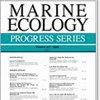Shifts in species composition in kelp forest communities: implications of differences in total phenolic composition among species
IF 2.1
3区 环境科学与生态学
Q2 ECOLOGY
引用次数: 0
Abstract
ABSTRACT: The purpose of our study was to measure total phenolic concentrations (TPC) of 14 species in the Phaeophyceae comprising kelp beds in the Otago Harbour Region (New Zealand). Our survey included 9 fucoids (order Fucales), 4 ‘true kelps’ (order Laminariales), and 1 species in the order Desmarestiales over 4 seasons from multiple sheltered and wave-exposed sites. TPC observed among species varied by 2 orders of magnitude from the most concentrated in Carpophyllum flexuosum (estimated marginal mean [emmean] 212.6 ± 24.77 µmol per gram dry tissue weight [g DTW-1]) to the least concentrated in Lessonia variegata (emmean 10.88 ± 2.84 µmol g DTW-1). Within the sheltered kelp bed communities of the Otago Harbour, TPC was higher in the warmer months and lower in the cooler months within species. In the wave-exposed communities, TPC was on average higher in the spring compared to the summer within the observed community. Lastly, within one species across both inner and outer Harbour communities, a Vargha and Delaney’s A measure suggests a specimen collected from the sheltered inner harbour sites would have a higher probability of being more concentrated in TPC than a specimen from the wave-exposed sites in the spring and summer (A-estimates 0.90 and 0.76, respectively) and a high probability of being more concentrated in the winter (A-estimate 0.70). Overall, variation in TPC among species within macroalgal communities suggests shifts toward more opportunistic species may impact community-wide TPC. Changes in species composition have important implications for the palatability of organic matter produced from macroalgal communities and the pathways for macroalgal-derived organic matter into coastal food webs.海藻森林群落中物种组成的变化:物种间总酚组成差异的影响
摘要:我们研究的目的是测量奥塔哥港地区(新西兰)海藻海床中 14 个物种的总酚浓度(TPC)。我们的调查包括 9 个褐藻(Fucales 目)、4 个 "真海带"(Laminariales 目)和 Desmarestiales 目中的 1 个物种,调查时间跨度为 4 个季节,来自多个遮蔽和海浪暴露的地点。在不同物种之间观察到的 TPC 有 2 个数量级的差异,从浓度最高的 Carpophyllum flexuosum(估计边际平均值 [emmean] 212.6 ± 24.77 µmol 每克干组织重量 [g DTW-1])到浓度最低的 Lessonia variegata(估计边际平均值 10.88 ± 2.84 µmol g DTW-1)。在奥塔哥港的遮蔽海带海床群落中,各物种的 TPC 在温暖的月份较高,而在凉爽的月份较低。在波浪暴露的群落中,在观察到的群落中,春季的总碳酸钙平均高于夏季。最后,在内港和外港群落中的一个物种内,瓦尔加和德莱尼的 A 测量表明,在春季和夏季,从遮蔽的内港地点采集的标本比从海浪暴露地点采集的标本的 TPC 更集中的概率更高(A 估计值分别为 0.90 和 0.76),而在冬季更集中的概率较高(A 估计值为 0.70)。总体而言,大型藻类群落中不同物种之间的 TPC 变化表明,向机会性更强的物种转变可能会影响整个群落的 TPC。这些变化对大型藻类群落产生的有机物的适口性以及大型藻类产生的有机物进入沿岸食物网的途径都有重要影响。
本文章由计算机程序翻译,如有差异,请以英文原文为准。
求助全文
约1分钟内获得全文
求助全文
来源期刊

Marine Ecology Progress Series
环境科学-海洋学
CiteScore
5.30
自引率
8.00%
发文量
238
审稿时长
3 months
期刊介绍:
The leading journal in its field, MEPS covers all aspects of marine ecology, fundamental and applied. Topics covered include microbiology, botany, zoology, ecosystem research, biological oceanography, ecological aspects of fisheries and aquaculture, pollution, environmental protection, conservation, and resource management.
 求助内容:
求助内容: 应助结果提醒方式:
应助结果提醒方式:


